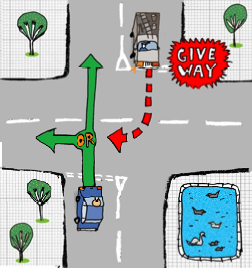Crossroads are some of the more challenging spots on the road. Four routes meet, traffic flows from all directions and the rules are not always obvious. Understanding who has priority is essential for avoiding accidents and driving with confidence.
Start by Reading the Road
Before you even reach the centre of the junction, slow down and look for signs or markings. White lines, stop signs and give-way triangles are there to tell you who should wait.
- A major road usually has no stop or give-way markings.
- Minor roads will show a clear line where you must yield.
- If you cannot see markings, approach as if nobody has priority.
This first step is the same whether you are learning to drive or have years of experience. Observing early gives you time to plan.

Emerging from a Crossroads
When you leave a crossroads to join another road, the general rule is simple: give way to oncoming traffic. This is vital when you are turning right across the path of vehicles coming towards you.
Even when markings give you priority, be ready to stop if a driver misreads the junction or tries to push through. A moment of patience is safer than a sudden brake.
Turning into a Side Road
If you are driving on the main road and want to turn into a side road, you usually keep priority over traffic trying to come out of that side road.
But never assume the driver waiting to emerge will stay put. They may not have seen you. Check both sides as you turn, keep your speed low and be ready to pause.
When Two Drivers Want to Turn Right
Crossroads often see two vehicles, opposite each other, both waiting to turn right. Who goes first?
There is no automatic right of way. It depends on markings and on you and the other driver communicating.
Two common methods are:
- Offside to offside: You both turn behind each other’s rear. This gives a clear view of oncoming traffic.
- Nearside to nearside: You both turn in front of each other. It can block your view and is less common.
If you are unsure, slow down, signal clearly and make eye contact. Whoever moves first should do so smoothly while the other waits.
Unmarked Crossroads
An unmarked crossroads has no signs and no painted lines. In theory everyone has equal priority.
To stay safe:
- Approach at a crawl.
- Be prepared to stop.
- Let the first vehicle to arrive go first.
- If you and another vehicle reach the junction at the same time, use hand signals or eye contact to decide who goes.
Do not rush or try to force your way through. Caution here prevents accidents.
Staggered Crossroads
A staggered crossroads looks like two T-junctions offset from each other. Roads do not meet directly opposite.
These layouts can confuse drivers. Your best approach is to treat them like unmarked crossroads unless signs or markings give clear instructions. Move slowly and check both junctions before committing to your turn.
When Other Drivers Break the Rules
Not every driver follows the Highway Code. Some may wave you through even when they have priority. Others may insist on going first.
Stay alert and be ready to give way, even when the rules say you can move. It is better to let a pushy driver go than to risk a collision. Defensive driving protects you and everyone around you.
Tips for Learner Drivers
Crossroads can feel a bit scary when you are new to driving. These tips help build confidence:
- Practice with a qualified instructor. Real practice is the best way to learn.
- Stay calm and breathe. Anxiety leads to mistakes.
- Approach slowly. Give yourself more time to read the junction.
- Watch other vehicles carefully. Their speed and signals show what they plan to do.
- Expect the unexpected. Always be ready to stop.
Repeated practice will make judging priority second nature.
Frequent Mistakes to Avoid
Even experienced drivers can get crossroads wrong. The most common errors are:
- Assuming you have priority when markings say otherwise.
- Failing to check both side roads before turning.
- Misreading a staggered layout and pulling out too soon.
- Driving too fast to react when another car appears suddenly.
Awareness of these mistakes helps you avoid them.
Why Getting It Right Matters
Crossroads are high-risk spots for collisions because so many paths cross. Misunderstanding priority is a key cause of accidents.
By learning the rules and keeping your speed down you:
- Reduce the chance of a crash.
- Protect passengers and pedestrians.
- Drive more confidently in busy areas.
This knowledge is also essential for passing your driving test and for safe everyday driving.
Quick Reference Table
| Situation | Who Normally Has Priority |
| Turning right across traffic | Oncoming vehicles going straight |
| Turning into a side road | You, but check both sides |
| Two vehicles turning right | No set priority, communicate |
| Unmarked crossroads | First to arrive, proceed with caution |
| Staggered crossroads | Treat as unmarked unless signed |
Wrapping Up
Crossroads test a driver’s observation and patience. Always check signs and markings first. If you are unsure, slow down and be ready to give way.
Confidence at crossroads comes from practice, but the rule never changes: safety is more important than claiming priority. Approach each junction with care and you will make the right decision every time.
Ready to build real driving confidence and master crossroads safely? Book your lessons now with Wimbledon Driving School and let our award-winning instructors guide you to success. Call 020 3524 7968 or book your first lesson online.


